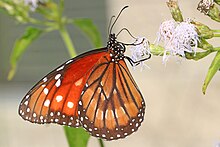| Soldier | |
|---|---|

| |

| |
| Conservation status | |
 Secure (NatureServe) | |
| Scientific classification | |
| Domain: | Eukaryota |
| Kingdom: | Animalia |
| Phylum: | Arthropoda |
| Class: | Insecta |
| Order: | Lepidoptera |
| Family: | Nymphalidae |
| Genus: | Danaus |
| Species: | D. eresimus |
| Binomial name | |
| Danaus eresimus (Cramer, ) | |
Danaus eresimus, the soldier or tropical queen, is a North American, Caribbean, and South American butterfly in the family Nymphalidae.
Their flight is slow and they are reasonably easy to approach, but will fly for some distance if approached too closely.
-
 Dorsal view - MHNT
Dorsal view - MHNT
-
 Ventral view, same specimen
Ventral view, same specimen
Description
The upperside of the wings is dark reddish brown with the forewing sometimes having white submarginal spots. The veins are lightly marked with black. Males have a black scent patch on each of the hindwings. The underside of the wings is also dark brown with a postmedian band made up of squarish spots. The soldier has a wingspan of 2+1⁄2 to 3+1⁄2 inches (64–76 mm). D. e. flexaure, formerly D. flexaure, is a subspecies which has more white markings on the hindwing underside.
Similar species
Similar species in the soldier's range include the monarch (Danaus plexippus) and the queen (Danaus gilippus).
The monarch is more orange, has heavier black-lined veins, and the underside of the wings is a pale yellowish color.
The queen has nearly no black-marked veins, and has white forewing submarginal spots on both surfaces of the wings.
Habitat
The soldier may be found in a variety of open, subtropical habitats such as citrus groves, weedy water edges where host plants occur, dry fields, etc.
Flight
This butterfly may be encountered from February to December in southern Florida (it is most common in October to December), and from August to January in southern Texas.
Life cycle
Males patrol for females. The eggs are bright orange. The black larva is banded with white and yellow stripes. It has a subdorsal row of yellowish-tan spots. There are six black, fleshy filaments, the first pair near the head, the second on the thorax, and the third at the end of the abdomen. The chrysalis is very similar to that of the monarch, often indistinguishable. It has three or more broods per year.
Host plants
- Strangler vine, Morrenia odorata
- White vine, Funastrum clausum
- West Indian pinkroot, Spigelia anthelmia
References
- Opler, P. A.; A. D. Warren (2002). "Danaus eresimus". NatureServe. Retrieved 12 July 2013.
- ^ Rick Cech and Guy Tudor (2005). Butterflies of the East Coast. Princeton University Press, Princeton, NJ. ISBN 0-691-09055-6
- Butterflies and Moths Additional Soldier Images
- Bob Stewart, Priscilla Brodkin and Hank Brodkin (2001). Butterflies of Arizona. West Coast Lady Press. ISBN 0-9663072-1-6
- ^ Jim P. Brock and Kenn Kaufman (2003). Butterflies of North America. Houghton Mifflin, New York, NY. ISBN 0-618-15312-8
- ^ James A. Scott (1986). The Butterflies of North America. Stanford University Press, Stanford, CA. ISBN 0-8047-2013-4
| Taxon identifiers | |
|---|---|
| Danaus eresimus | |